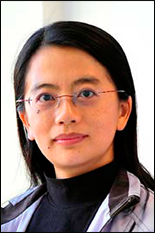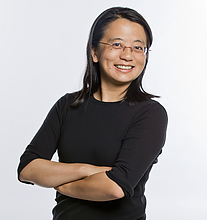News Story
ECE Professor and Students Win Invention of the Year Award

Professor Min Wu
Professor Min Wu and her Ph.D. students Hui Su and Adi Hajj-Ahmad won the 2015 University of Maryland Invention of the Year Award in Information Science for a method they have identified to extract Electrical Network Frequency (ENF) signals from video recordings of complex and realistic scenarios to be used in a variety of applications including security and forensics, digital humanities and immersive multimedia.
The invention was one of nine nominated for the Invention of the Year Award and was presented during the UMD Celebration of Innovation and Partnerships, sponsored by the Office of Technology Commercialization, the Corporate Connect Council, and the Academy of Innovation of Entrepreneurship.
The invention successfully extracts ENF from videos that have moving objects, changing brightness settings and moving cameras, representing an advancement from the previous applications with capabilities demonstrated only for static video. The invention also includes a novel application of ENF to temporal multimedia synchronization supporting an immersive multimedia experience. This new modality for synchronization imposes no constraints on camera calibration or view angle and no content overlap between media streams is required.
The technology developed by Professor of Electrical and Computer Engineering Min Wu (ECE/ISR/UMIACS), along with ECE graduate students and members of her research group Hui Su and Adi Hajj-Ahmad, uses the effects of the rolling shutter mechanism, found in most digital cameras in use today, to capture the ENF signals.
“The capabilities that our invention provides are unprecedented,” Wu said. “The technologies in particular are a leap forward from the prior art in order to enable ENF extraction from a wider range of video recordings.”
With this invention, the research team has demonstrated the novel ways in which ENF could be used for multimedia synchronization. Wu said that most conventional video synchronization methods rely on visual cues, and other features including sufficient video overlap and imposing constraints on camera calibration.
“The capabilities that our invention provides are unprecedented.”
Min Wu
“ENF-based video synchronization does not rely on the perceptual audio and visual information of recordings, but rather on the embedded ENF traces,” Wu said. This makes the invention different from conventional methods that require constraints on viewing angles, camera calibration, and motion of the recording.
Wu said that the ENF could be used for forensic and security applications like verifying or estimating the time-of-recording of a media signal. Other uses are to verify the authenticity of a media signal, detecting tampering, as well as verifying or finding the location-of-recording of a media signal.
In addition, interestingly, this research group, through their interactions with researchers from the iSchool, found that ENF traces can be found in analog historical recordings, such as tapes from the Apollo moon landing missions and former U.S. President John F. Kennedy’s meeting recordings from the White House.
“Our ongoing work is exploring the potential of ENF for preservation and exploration of historical records under the umbrella of digital humanities, for example, assembling a historical database of time-stamped ENF variations, which can then be used to timestamp historical recordings of interest,” Wu said.
Future research plans include the exploration of new ENF extraction approaches to improve on current methods and the exploration of new applications of ENF.
“Another direction of future work is exploring improved video synchronization modalities, such as a combination of our ENF-based approach and the visual cue-based method to form a more effective and robust framework,” Wu said.
Published April 30, 2015








